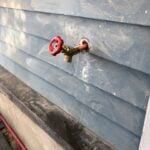According to the Canadian Association of Petroleum Producers (CAPP), “Horizontal Directionally Drilling (HDD) is a proven technique for the installation of pipelines and other utilities in sensitive or congested areas.”
Profitability is always in the mind of every contractor when drilling. To achieve this, a contractor has to come up with a better strategy for completing the project within the stipulated time frame.
They have to use the right machines, proper skills, and correct techniques to achieve his objectives. Leveraging the right techniques will prevent them from any unpleasant conditions resulting from hazards.
That being said, the best approach is always directional drilling.
When drilling to find water, oil, or natural gas, you bore vertically down in a straight line. You might have to deviate to avoid any geographical formation.
The constructor could also be avoiding a previous stuck pipe. As you progress, you can go back to your original path. You will have to use a “sidetracking technique” to achieve this.
Any method that doesn’t follow a straight line vertically is called directional drilling.
What is Horizontal Directional Drilling (HDD)?
Horizontal Directional Drilling (HDD) is a construction technique whereby a tunnel is drilled under a waterway or other designated area, and a pipeline or other utility is pulled through the drilled underground tunnel.
Directional drilling technique has been in existence for long. With the advancement of technology, engineers continue to come up with fantastic methods of drilling.
It has helped them to be able to achieve precise angles and turns. They are also able to cover the tremendous underground distance.
One of the most amazing techniques, perhaps the oldest is the horizontal directional drilling (HDD). This technique is also controversial. You can get a land tender that will give you the right to explore and find natural resources.
You can then extract them in a square meterage of land. Some offer you the freedom to drill horizontally up to the territory of your neighbor. Some countries are known to use this technique to dig to the region of neighboring countries.
Directional Drilling Guidelines
- General Requirements
- You must dispose of all excavated materials as per the relevant environmental conditions.
- The HDD professional must always be present when operations are underway.
- Temporally works need to be demolished after the completion of the project.
- Workforce requirements
- Contractors must have a relevant license
- The relevant authority must approve the incense before commencement.
- Utility location
You should do a survey to establish where critical underground utilities are, before any drilling. Examples include petroleum pipes, electricity, and sewer lines.
- Construction Procedure
Before commencing on any work, the constructor has to submit to the administration construction procedures he intends to follow. The job only begins if the authority approves.
- Risk Assessment and Control
Before drilling, a constructor should access any HDD risk and come up with a contingency plan. The plan should be well-designed to deal with any possible danger.
Such risks include drill fluid loss, hydrofracture event, in case a hole collapses, and fluid pit overflow. They also have to plan what they will do in case of a drill pipe failure.
The constructor has to observe general workplace safety and environmental incidences.
- Project Preliminaries
Every horizontal drilling project requires approval before commencement. The relevant authority must sign all appropriate permits. They must follow the allowed design requirements. A drawing design requires three columns:
- Drawing description
- Drawing details
- Comments.
You have to include the borehole details, pit’s entry and exit, the general arrangement of the HDD and the site layout. You have to consider the minimum depth below the road and the bore alignment.
- Materials and Equipment
You must prepare suppliers certificates and present to the administration, of all the permanent materials you intend to use. You must describe any available HDD pipe materials.
- Quality System Requirement
There are general requirements that one should have a hold point, a witness point and also milestones.
- Tolerances
You have to follow the approved design alignment. You can’t afford to fail to conform to allowable tolerances.
- Constructed Records
Before ten days end after completing the work, you should submit some constructed records, such records include:
- Completed HDD bore survey records
- Installation steering documents
- Grouting records.
- Ground deformation monitoring records.
- Final dilapidation reports
Advantages Of Boring Horizontally
- When drilling in a straight line vertically, the pressure tends to increase around the wellbore. But when drilling horizontally, the pressure reduces.
- When using this technique, you will realize that around your well, there’s a lower fluid velocity.
- There is a reduction in soil production.
- You increase your overall reservoir recovery when using the technique. The reason is that the drainage pattern is more efficient and more extensive.
- It increases the production rate since you expose the length of the greater wellbore to the pay zone.
- Reduced conning of water and gas
Additional Benefits of Horizontal Drilling
- Hit Target
There might be reservoirs under a city or even a park. Drilling vertically in a straight line might not be possible. The government might have forbidden extractions in those areas.
When you use horizontal directional drilling, however, you will be able to achieve your objective.
- Drain a Broad Area
In a single drill pad, you can drain vast areas. One of the most surprising episodes was back in 2010. The University of Texas from a town called Arlington hit the headlines.
From a single drill pad, they managed to drill 22 wells. They intended to drain 1,100 acres of natural gas that is beneath their campus. That means in the next 25 years; they might produce gas in 110 billion cubic feet.
- Increase Pay Length
When drilling in a vertical direction, the distance of penetration into the well of oil or gas is lower. When using horizontal drilling, the range of penetration is substantial, therefore increasing the pay zone.
Instances Where You Can Use Horizontal Directional Drilling
- Oil-Saturated Sad: When drilling oil-saturated sand, the best method to use is horizontal drilling
- Tough Rocks: When trying to extract resources in places with tough stones, it might be so tricky to drill vertically. You have to use horizontal directional to avoid the rocks.
- Inaccessible Areas: Imagine drilling resources under big building in town or maybe in a mountain or a natural reservoir. It can be very tricky boring using a vertical strain line. But it’s possible if you use horizontal directional drilling.
- Multiple Bed Dips: In some cases, you might find that the oil and gas settle in separate, distinct pockets. To access both points, you will have to drill horizontally. If they are in a single deposit, you can comfortably use vertical drilling alone.
- Lag Rig: Did you know that it’s possible to drill on the land then move horizontally under an ocean or lake? Of course, you can’t get into the sea and drill when you are inside; the risk could be high.
Conclusion
When drilling, you can use different techniques. One of the best methods is the use of the HDD. It has many advantages since you can use it in areas where vertical straight line drilling cannot work.
You have to follow the right guidelines. Talk to the Administration and get all information concerning all requirements of drilling. For the sake of everyone, risk assessment is vital. If you’re not so conversant, you can engage the experts. You don’t want to find yourself on the wrong side of the law.

